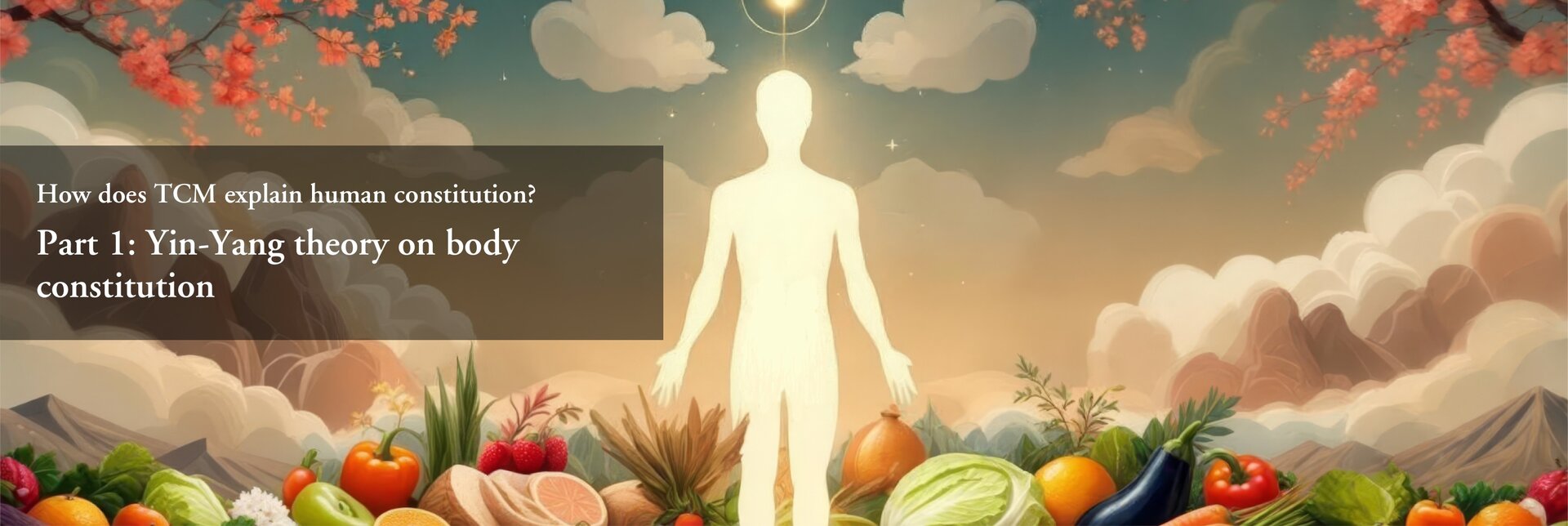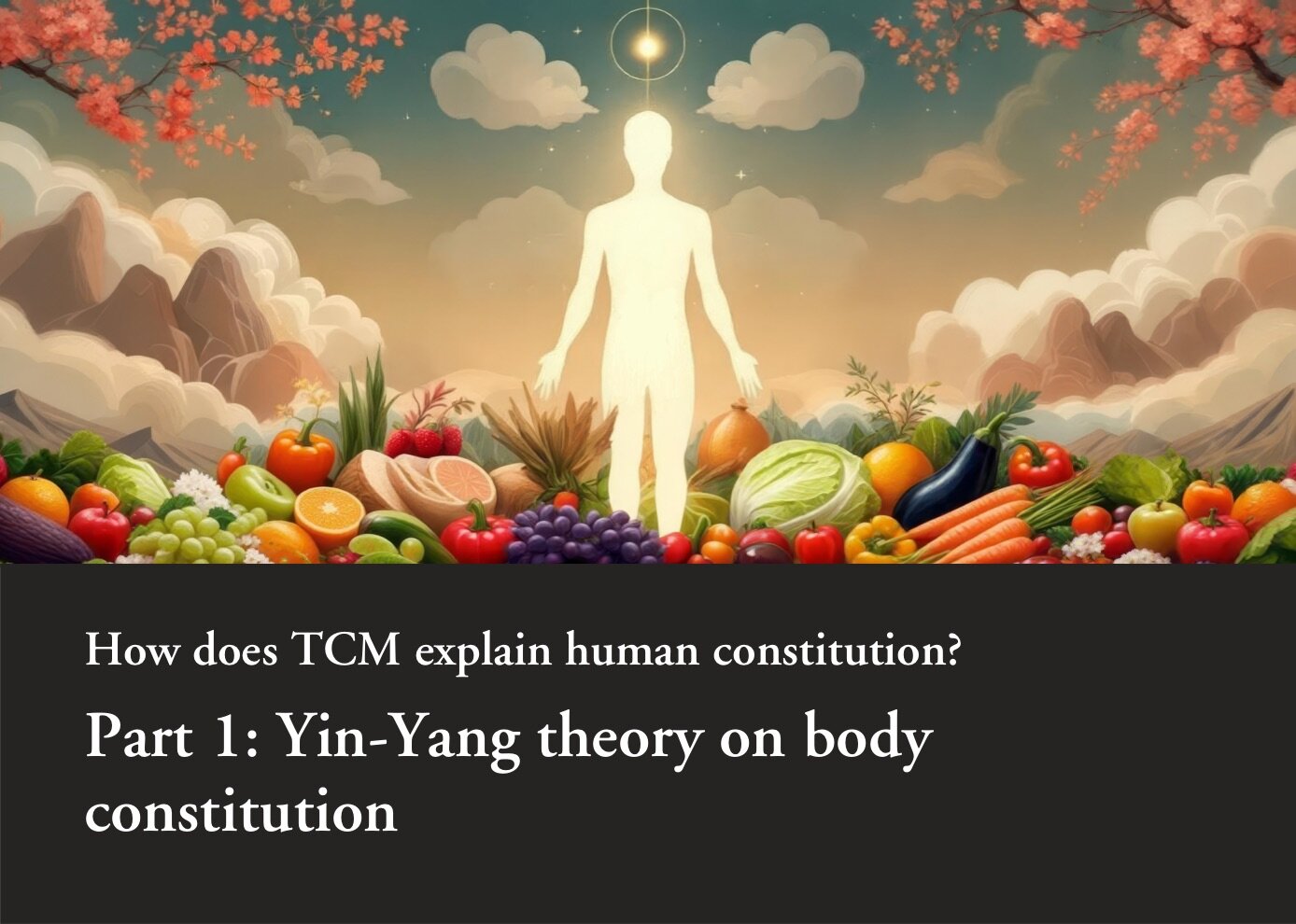How does TCM explain human constitution?
(Part 1: Yin-Yang theory on body constitution)
The concept of constitution in TCM is based on the theory of TCM, which is the characteristics of the human body formed through innate endowment, acquired environment, growth and aging. The concept of constitution was recorded as early as in "The Yellow Emperor Neijing: Yin Yang Five Forms of Human Beings黃帝內經: 陰陽五態之人". Later, 張仲景Zhang Zhongjing's "Treatise on Febrile and Miscellaneous Diseases: Six Meridian Constitution 傷寒雜病論: 六經體質" began to apply the concept of Yin Yang constitution to diagnosis. Zhang Jingyue's "Jingyue Complete Works: Yin Yang Principles and Constitution Theory 《景嶽全書: 陰陽二綱體質論》" divided the human body constitution into Yang prevailing Yin and Yin prevailing Yang. Since then, successive generations of TCM doctors have continuously expanded and extended the theory of constitution and began to apply the idea of constitution to clinical research in traditional Chinese medicine. In modern times, Professor Wang Qi of Beijing University of Traditional Chinese Medicine conducted clinical and basic research and divided human constitution into nine categories. Each constitution has its own unique morphological characteristics, psychological characteristics, physiological functions, environmental adaptability, and pathological symptoms.
2.1 The classification of people in the five states of yin and yang in "The Yellow Emperor's Neijing Lingshu: Yin and Yang Chapter of Tongtian" (黃帝內經 靈樞:通天陰陽篇.)
Based on the theory of yin yang balance, and according to personal character, muscles and bones, qi and blood, people are divided into five types of constitutions: people who are too yin, people who are less yin, people who are less yang, people who are too yang, and people who are balance in yin and yang. People with a strong yang constitution have 4 characteristics: hot, dry, high, and active, and people with a strong yin constitution also have 4 characteristics: cold, wet, low, and quiet, and people with a harmonious yin and yang, who are not afraid of cold or heat.
People of Taiyang constitution: Excessive yang and less in yin, impatience and irritability (e.g., fiery physique).
Treatment method: Too much yang and little yin, purging its yang (clearing heat and dispelling fire from the body).
Heat-clearing foods: cabbage, amaranth, bitter gourd, watermelon, banana, mung bean, tofu, honeysuckle, chrysanthemum, kiwifruit, tomato, sugarcane.
People of Shaoyang constitution: Balanced yang and less in yin, extroverted and active, but easily impulsive (tend to be peaceful but still leaning towards yang).
Treatment method: balanced Yang with less Yin, enrich its Yin, (nourish Yin and clear heat).
Foods that nourish yin and clear heat: lily, white fungus, wolfberry, yellow essence, pine nuts, black pelican, duck meat, pork, milk, Jiang Gui, black sesame.
Peaceful people: Healthy balance yang and yin (balanced yin and yang constitution).
Treatment method: Balanced diet
People of Shaoyin constitution: The constitution is balanced yin and little yang, introverted and calm, prone to depression (like qi stagnation, yang deficiency constitution).
Treatment method: more yin and less yang, replenish the yang, (replenish yang and warm the interior body).
Foods to replenish yang and warm the interior: cordyceps, mutton, shrimp, sea cucumber, walnut, chestnut, eel, glutinous rice, longan meat, curculigo, alpinia oxyphylla, eucommia bark, cinnamon.
People of Taiyin constitution: Constitution with more Yin and less Yang, excessive Yin and cold, and taciturn (e.g. Yang deficiency constitution + cold and damp constitution).
Treatment method: too much Yin and too little Yang, drain the Yin (warm the body and drive away the cold).
Foods that warm the body and drive away the cold: leek, grass carp, ginger, fennel, brown sugar, dried ginger, pepper, cloves, star anise.
2.2 Theory of Yin-Yang Constitution in Zhang Jingyue Complete Works of Jingyue 張景岳《景嶽全書》陰陽二綱體質理論
Zhang Jingyue《Jingyue Complete Works》states that when yin and yang are balanced, the spirit is healed. Normal life activities are the result of the coordination of the opposition and unity of yin and yang in the human body. Zhang Jingyue believes that "human diseases are not caused by one side, but either yang is excessive, and yin is insufficient, or yin is excessive, and yang is insufficient". Constitution can be attributed to the imbalance of yin and yang, which can be divided into two categories: 1. Yang-dominant yin constitution: yang heat is excessive, and yin fluid is insufficient; 2. Yin-dominant yang constitution: yin cold is excessive, and yang is weak.
Constitution of Yang prevails over Yin (Yin deficiency and Yang hyperactivity type): thin, reddish complexion, dry skin, hot sensation in the five parts of the body, night sweats, dry mouth, and throat.
Treatment methods: nourishing Yin and reducing fire (replenishing Yin, clearing away heat due to yin deficiency)
Yin-replenishing foods: lily, white fungus, wolfberry, polygonatum, pine nuts, black chicken, duck, pork, milk, cassia bark, black sesame.
Health-preserving diet therapy: 1) rock sugar, snow fungus and lotus seed soup, 2) polygonatum odoratum and adenophora stewed with old duck, 3) apricot juice pig lung soup, 4) papaya snow lotus and lily syrup.
Constitution of Yin win over Yang (Yang deficiency-Yin excess type): puffiness or emaciation, pale complexion, fear of cold and cold limbs, sore waist and knees, frequent urination at night, loose stools.
Treatment method: warming Yang and dispelling cold (replenishing the fire of the gate of life and expelling Yin cold)
Yang-replenishing foods: cordyceps, mutton, shrimp, sea cucumber, walnut, chestnut, eel, glutinous rice, longan meat, curculigo, alpinia oxyphylla, eucommia, cinnamon.
Health-preserving diet therapy: angelica, ginger and mutton soup, walnut, eucommia and pork kidney soup, ginger, jujube and brown sugar water, Korean ginseng chicken soup
Traditional Chinese medicine selects appropriate foods and medicines according to individual constitution and symptoms to achieve the purpose of health enhancement, diseases prevention, and treatment. This TCM Medical Hall starts with the theories of yin and yang, five elements, internal organs, cold and heat, deficiency and excess, pathology, and nine types of constitutions nowadays. It chooses yin and yang as the starting point to let readers understand their personal constitution, regulate their health, and prevent diseases.
All articles/videos are prohibited from reproducing without the permission of the copyright holder.




Welcome to leave a message:
Please Sign In/Sign Up as a member and leave a message